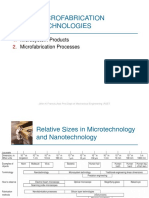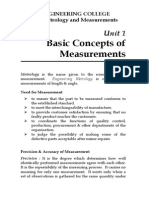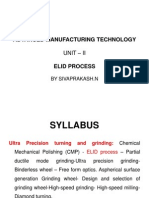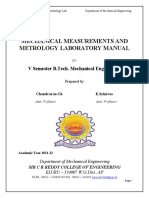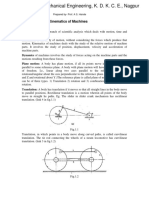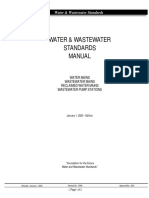0 ratings0% found this document useful (0 votes)
269 viewsRecent Trends in Non-Traditional Machining Processes: Unit - 5
Recent Trends in Non-Traditional Machining Processes: Unit - 5
Uploaded by
DISHA VElectrochemical spark machining (ECSM) is a hybrid machining process that combines electrochemical machining and electrodischarge machining. It can machine metals, ceramics, composites, and other difficult-to-machine materials. In ECSM, a voltage is applied between two electrodes submerged in an electrolyte, generating gas bubbles that allow spark discharges to occur. These sparks melt and evaporate small amounts of material from the workpiece, enabling precision microfabrication applications. However, cracking of brittle materials remains a challenge for ECSM to become more practical.
Copyright:
© All Rights Reserved
Available Formats
Download as PPT, PDF, TXT or read online from Scribd
Recent Trends in Non-Traditional Machining Processes: Unit - 5
Recent Trends in Non-Traditional Machining Processes: Unit - 5
Uploaded by
DISHA V0 ratings0% found this document useful (0 votes)
269 views12 pagesElectrochemical spark machining (ECSM) is a hybrid machining process that combines electrochemical machining and electrodischarge machining. It can machine metals, ceramics, composites, and other difficult-to-machine materials. In ECSM, a voltage is applied between two electrodes submerged in an electrolyte, generating gas bubbles that allow spark discharges to occur. These sparks melt and evaporate small amounts of material from the workpiece, enabling precision microfabrication applications. However, cracking of brittle materials remains a challenge for ECSM to become more practical.
Original Description:
UCMP -UNIT5 (2017 Regulations)
Original Title
UCMP-Unit 5
Copyright
© © All Rights Reserved
Available Formats
PPT, PDF, TXT or read online from Scribd
Share this document
Did you find this document useful?
Is this content inappropriate?
Electrochemical spark machining (ECSM) is a hybrid machining process that combines electrochemical machining and electrodischarge machining. It can machine metals, ceramics, composites, and other difficult-to-machine materials. In ECSM, a voltage is applied between two electrodes submerged in an electrolyte, generating gas bubbles that allow spark discharges to occur. These sparks melt and evaporate small amounts of material from the workpiece, enabling precision microfabrication applications. However, cracking of brittle materials remains a challenge for ECSM to become more practical.
Copyright:
© All Rights Reserved
Available Formats
Download as PPT, PDF, TXT or read online from Scribd
Download as ppt, pdf, or txt
0 ratings0% found this document useful (0 votes)
269 views12 pagesRecent Trends in Non-Traditional Machining Processes: Unit - 5
Recent Trends in Non-Traditional Machining Processes: Unit - 5
Uploaded by
DISHA VElectrochemical spark machining (ECSM) is a hybrid machining process that combines electrochemical machining and electrodischarge machining. It can machine metals, ceramics, composites, and other difficult-to-machine materials. In ECSM, a voltage is applied between two electrodes submerged in an electrolyte, generating gas bubbles that allow spark discharges to occur. These sparks melt and evaporate small amounts of material from the workpiece, enabling precision microfabrication applications. However, cracking of brittle materials remains a challenge for ECSM to become more practical.
Copyright:
© All Rights Reserved
Available Formats
Download as PPT, PDF, TXT or read online from Scribd
Download as ppt, pdf, or txt
You are on page 1of 12
UNIT – 5
RECENT TRENDS IN NON-
TRADITIONAL MACHINING
PROCESSES
Electrochemical Sparks Machining
Process
• Electro Chemical Spark Machining (ECSM) is an important
process as it can be applied to metal, ceramics, smart
material, composites. It can be applied in micro fabrication,
heat treatment, welding.
• Advanced ceramics and composites have high potential for
their application in various field of engineering due to their
superior properties such as high compressive strength,
good thermal shock resistance, high wear resistance, high
hardness, high strength, to weight ratio such improved
material properties have new challenges in manufacturing.
• ECSM can become a practical solution for these problems.
There is need of research for better control, cracking of
material, deep drilling, tool wear etc.
• Shaping of the difficult-to-machine non-conductive materials such
as glass, quartz and ceramic is much difficult and uneconomical by
existing machining processes.
• As a result, wide applicabilities of these materials are still limited.
Even though these materials are highly required in the field of the
modern industries.
• To overcome the problem, a new machining method has been
proposed by researchers by combining the features of electro-
chemical machining and electro-discharge machining.
• Such combined machining process is called as electro-chemical
spark machining process.
• Such developed machining method becomes an appropriate
process for machining of non-conductive materials with significant
improvement in productivity as compared to the electro-discharge
machining and electro-chemical machining processes.
Introduction
• Machining is process of controlled removal of material from
workpiece to get desired dimensions required for engineering
component.
• In traditional machining process tool material should be harder
than work piece material. This limitation is overcome by many
advanced manufacturing techniques, like Ultrasonic machining
(USM), Electrochemical machining (ECM), Electro discharge
machining (EDM), etc.
• To get advantage of more than one non-conventional machining
there immerged concept of Hybrid machining. Electro chemical
spark machining (ECSM) is also a hybrid machining process which is
combination of Electrochemical machining (ECM) & Electro
discharge machining (EDM) which is also known as, Electrochemical
Engraving, Electrochemical Discharge Machining etc.
Mechanism of generation of spark in
electrolyte
• In ECSM process generally two electrodes are largely different in
size. Machining may takes place at cathode and anode. The
electrode which is used as tool is called active electrode and which
is small in size compared to another electrode, which is called as
auxiliary electrode.
• Work piece is kept near to active electrode. Here, voltage applied is
also large. Due to small shape at active electrode there is large
current density so large amount of gas is generated there.
• This gas is nonconductive in nature. So this gas film acts as high
resistance for electric current so ohmic heating also takes place &
more number of gas bubbles are generated this gas is passivate
active electrode.
• As applied voltage is above break down voltage of gas film there is
occurrence of spark. Due to this spark gas layer break down takes
place & again electrochemical reaction starts. This process
continues. Generally power applied in pulsed form of micro second
range. This process is shown by operation flow of ECSM
Material removal mechanism of ECSM
operation
• In the ECSM process, the material removal takes place due to the combined
effects of electrochemical reaction and electrical spark discharge action.
• Fig.2.3 exhibits the material removal mechanism of ECSM operation.
Although the tool is touching the surface of the work piece, there are micro
gaps between the tool and the work piece due to the surface irregularity
present on both the surfaces of tool and that of the work piece.
• The electrolyte present in the micro gaps is responsible for the formation of
gas bubbles and steam generation. A low ionic layer is formed in the micro
gaps and the surrounding tool surface. When the voltage gradient that is set
up is sufficient to breakdown the gas bubble layer between the tool and the
work piece, a conducting path is developed for spark discharge owing to the
ionization of the gas bubble, which thereby causes the flow of a large
amount of current.
• Each electrical discharge causes a stream of electrons to
move with a very high velocity and acceleration from the
cathode (or tool) towards the work piece and ultimately
creates compressive shock waves on the work piece
surfaces.
• The phenomenon is completed within a few microseconds
and the temperature of the spot hit by electrons may rise
to a very high value. As this high temperature is above the
melting point of the work piece material, it melts and
finally evaporates the material.
• The high pressure of the compressive shock waves creates
a blast, causing metallic vapors to form wear products in
the shape of metallic globules, leaving craters in the work
piece surface
ADVANTAGES
• ECSM is very good process that can be applied to metal,
ceramic, composite and non conductive material.
• It has less MRR but that is advantage during micromachining.
• Main obstacle to apply ECSM to miniature component is crack
near machining.
• MRR is also dependent on many parameters. To increase
reproducibility of ECSM, there is need of research to control
over gas film during dynamic conditions of machining.
• This process has potential to heat treatment also. Comparing to
another non conventional process it has less setup cast, so by
proper modification it can become practical machining process
You might also like
- Ethical Hacking and Network DefenseDocument4 pagesEthical Hacking and Network DefenseCristian RamirezNo ratings yet
- Lab 1Document17 pagesLab 1Haonan WANGNo ratings yet
- CAEDPDocument2 pagesCAEDPDurgaprasad DhanivireddyNo ratings yet
- Internship Report FormatDocument4 pagesInternship Report FormatShan MalikNo ratings yet
- Electrochemical Machining (ECM)Document48 pagesElectrochemical Machining (ECM)vkrishnarajNo ratings yet
- Non Conventional Machining PDFDocument55 pagesNon Conventional Machining PDFMarthande100% (1)
- EDM, LBM and ECMDocument30 pagesEDM, LBM and ECMSparsh KatiyarNo ratings yet
- Hybrid Machining: Made By:-Hiragar Yashkumar Dalpatbhai Guidede By:-Alok SirDocument28 pagesHybrid Machining: Made By:-Hiragar Yashkumar Dalpatbhai Guidede By:-Alok SirYash Hiragar100% (1)
- Introduction To UCMPDocument27 pagesIntroduction To UCMPGowtham sivateja100% (2)
- Micro Electronic Mechanical Systems (MEMS)Document3 pagesMicro Electronic Mechanical Systems (MEMS)Aditya Narayan SahooNo ratings yet
- JNTUK - B Tech - 2018 - 4 1 - Mar - R16 R13 R10 - MECH - RT41037022018 MATERIAL CHARACTERIZATION TECHNIQUESDocument1 pageJNTUK - B Tech - 2018 - 4 1 - Mar - R16 R13 R10 - MECH - RT41037022018 MATERIAL CHARACTERIZATION TECHNIQUESConor StevensonNo ratings yet
- Lectut MIN-216 PDF UNIT 2 Advanced Manufacturing ProcessesDocument92 pagesLectut MIN-216 PDF UNIT 2 Advanced Manufacturing Processesvishal guptaNo ratings yet
- Chapter 1 - Introduction To Hybrid Machining ProcessesDocument31 pagesChapter 1 - Introduction To Hybrid Machining ProcessesGAURAV KUMAR100% (1)
- 2mark With Answer UCM M.E 6004 PDFDocument22 pages2mark With Answer UCM M.E 6004 PDFl8o8r8d8s8i8v8100% (1)
- Tittle:-Identify Various Additive Manufacturing Process and System and Prepare ReportDocument10 pagesTittle:-Identify Various Additive Manufacturing Process and System and Prepare Reportvishv PatelNo ratings yet
- Module 3 PDFDocument55 pagesModule 3 PDFSandeep VermaNo ratings yet
- ME8073 - UNCONVENTIONAL MACHINING PROCESSES SyllabusDocument2 pagesME8073 - UNCONVENTIONAL MACHINING PROCESSES SyllabusP.N. MohankumarNo ratings yet
- Engineering Metrology & Measurements NotesDocument48 pagesEngineering Metrology & Measurements NotesJeevanandam Shanmuga100% (1)
- Ee3301 Emf QPDocument4 pagesEe3301 Emf QPKeerthana SahadevanNo ratings yet
- Ucmp 2 Mark With AnswerDocument17 pagesUcmp 2 Mark With AnsweranithayesurajNo ratings yet
- Micro Machining Prof V K JainDocument70 pagesMicro Machining Prof V K JainJayant Kumar0% (1)
- Question Paper Code:: (10×2 20 Marks)Document2 pagesQuestion Paper Code:: (10×2 20 Marks)jastraNo ratings yet
- Module For Machine ElementsDocument28 pagesModule For Machine ElementsAce Heart Rosendo AmanteNo ratings yet
- Micro and Nano ManufacturingDocument14 pagesMicro and Nano ManufacturingAnonymous UtgBOszHNo ratings yet
- Automated Guided Vehicle System (AGVS)Document17 pagesAutomated Guided Vehicle System (AGVS)Anjan KumarNo ratings yet
- ELID GrindingDocument43 pagesELID GrindingStephen.K67% (3)
- Full Unit 1 NotesDocument65 pagesFull Unit 1 NotesRaagul SNo ratings yet
- Advanced Metal Casting Technology (MAT515) Assignment One Part OneDocument51 pagesAdvanced Metal Casting Technology (MAT515) Assignment One Part OneBizuayehu Tadesse100% (1)
- MOdern Welding ProcessesDocument25 pagesMOdern Welding ProcessesAnwar Sadath M A50% (2)
- Chap 7b Nanolithography Different TypesDocument42 pagesChap 7b Nanolithography Different TypesmeetbalakumarNo ratings yet
- Abrasive Jet MachiningDocument12 pagesAbrasive Jet MachiningTejas SuratiNo ratings yet
- ECDMDocument9 pagesECDMRobert NayakNo ratings yet
- ME3393 Manufacturing Processes 03 - by LearnEngineering - inDocument37 pagesME3393 Manufacturing Processes 03 - by LearnEngineering - inUrbhi SahaNo ratings yet
- MM&M LAB STUDENT MANUAL Front PagesDocument6 pagesMM&M LAB STUDENT MANUAL Front Pageschandrarao chNo ratings yet
- RP Question BankDocument4 pagesRP Question BankAkshay IyerNo ratings yet
- Slush CastingDocument20 pagesSlush Castingamt938100% (1)
- Chapter 5 - Electrochemical Based Hybrid Machining ProcessDocument36 pagesChapter 5 - Electrochemical Based Hybrid Machining ProcessHimanshu BisariaNo ratings yet
- V.K Jain-Advanced Machining Processes-Allied Publications PDFDocument369 pagesV.K Jain-Advanced Machining Processes-Allied Publications PDFA100% (1)
- Manufacturing Process Point Vise Syllabus From RaghuvanshiDocument3 pagesManufacturing Process Point Vise Syllabus From RaghuvanshiRAMAKANT RANANo ratings yet
- Chapter 2 - Overview of Hybrid Machining ProcessesDocument32 pagesChapter 2 - Overview of Hybrid Machining ProcessesAman BansalNo ratings yet
- Surface Coating ProcessesDocument7 pagesSurface Coating ProcessesSailabala ChoudhuryNo ratings yet
- Additive Manufacturing: Department of Mechanical EngineeringDocument64 pagesAdditive Manufacturing: Department of Mechanical EngineeringnareshNo ratings yet
- Mechatronic System DesignDocument34 pagesMechatronic System Designgreen_way26No ratings yet
- LLBMDocument15 pagesLLBMSanjay AcharyaNo ratings yet
- Kinematics of Machines PDFDocument133 pagesKinematics of Machines PDFarjunNo ratings yet
- Mechatronic System DesignDocument48 pagesMechatronic System Designanon_256385509No ratings yet
- Question: A Robotic Work Cell Has A Camera With in The Setup. The Origin ofDocument2 pagesQuestion: A Robotic Work Cell Has A Camera With in The Setup. The Origin ofAnmol Thakur AstNo ratings yet
- Mt-I 2 Marks With Answer PDFDocument15 pagesMt-I 2 Marks With Answer PDFSiva RamanNo ratings yet
- Assignment For UNIT IDocument2 pagesAssignment For UNIT IParamasivam VeerappanNo ratings yet
- Introduction To Non Conventional OperationsDocument13 pagesIntroduction To Non Conventional Operationssham javed100% (1)
- T.E - I (English) - N SchemeDocument353 pagesT.E - I (English) - N SchemeSakthiVelMNo ratings yet
- Advance MFG Processes Lecture1newDocument30 pagesAdvance MFG Processes Lecture1newirum,No ratings yet
- Nov Dec 2016 PPC Question PaperDocument21 pagesNov Dec 2016 PPC Question PapersathyadallyNo ratings yet
- Electroslag Welding: Electroslag Welding (ESW) Is A Highly Productive, Single PassDocument2 pagesElectroslag Welding: Electroslag Welding (ESW) Is A Highly Productive, Single PassStefanie WilsonNo ratings yet
- MT 1 Lab Manual PDFDocument40 pagesMT 1 Lab Manual PDFrajamanickam sNo ratings yet
- Advanced Manufacturing Technology 2-Marks Question and Answer Unit-IDocument44 pagesAdvanced Manufacturing Technology 2-Marks Question and Answer Unit-IM.ThirunavukkarasuNo ratings yet
- Metal Joining PrcocessDocument42 pagesMetal Joining PrcocessDheerajSharma100% (1)
- Electrochemical MachiningDocument104 pagesElectrochemical MachiningDeepak SharmaNo ratings yet
- Non Traditional Machining C 26Document52 pagesNon Traditional Machining C 26Ottoman Empire “Ottoman Empire wars”No ratings yet
- Electron Beam MachiningDocument33 pagesElectron Beam MachiningMr PotatoNo ratings yet
- Electron Beam Machining:: Principle of EBMDocument5 pagesElectron Beam Machining:: Principle of EBMZaky MuzaffarNo ratings yet
- TransformersDocument124 pagesTransformersRohini MukunthanNo ratings yet
- Prof Chibita Inaugural Lecture January 17 2020Document35 pagesProf Chibita Inaugural Lecture January 17 2020The Independent MagazineNo ratings yet
- MODULE 8. Sizing of Water LinesDocument4 pagesMODULE 8. Sizing of Water LinesFernando PascualNo ratings yet
- SeminarDocument2 pagesSeminarAerone SebastianNo ratings yet
- Ultimate Tiled 9mm EppDocument20 pagesUltimate Tiled 9mm EppDario DominguezNo ratings yet
- Cities of Glass: A History of Canadian Electronic Music, Pt3 - Tobias C. Van VeenDocument4 pagesCities of Glass: A History of Canadian Electronic Music, Pt3 - Tobias C. Van Veentobias c. van VeenNo ratings yet
- Amanda R DonnellyDocument1 pageAmanda R DonnellyAmanda DonnellyNo ratings yet
- Fci - ST50Document25 pagesFci - ST50Carlos Alfredo Rebolledo GodoyNo ratings yet
- Analyses For The Stability of Potash Tails PilesDocument15 pagesAnalyses For The Stability of Potash Tails Pilesronald_edinsonNo ratings yet
- The The Top 100 World UniversitiesDocument5 pagesThe The Top 100 World UniversitiesSundara PandyNo ratings yet
- Vacuum System Design ConsiderationsDocument20 pagesVacuum System Design ConsiderationschuyennbNo ratings yet
- 2020 Water Wastewater Standards ManualDocument739 pages2020 Water Wastewater Standards Manualbartsi1No ratings yet
- BRE Global Test Report: BS 476-7: 1997 Surface Spread of Flame Test On K-Flex Eco + AluDocument7 pagesBRE Global Test Report: BS 476-7: 1997 Surface Spread of Flame Test On K-Flex Eco + AluWah KhaingNo ratings yet
- Hospital Management SysytemDocument38 pagesHospital Management SysytemMr. Hasrat100% (1)
- Standard KSSR Tahun 1 Bi 2011Document27 pagesStandard KSSR Tahun 1 Bi 2011isaac_ash100% (1)
- Mandrel Built Hose Air Water HoseDocument6 pagesMandrel Built Hose Air Water HoseLeo Agung HastiNo ratings yet
- The AnswerDocument24 pagesThe Answerrezoka100% (1)
- 02 - Lecture - Chapter 2 - Digital Image FundamentalsDocument69 pages02 - Lecture - Chapter 2 - Digital Image FundamentalsrozNo ratings yet
- HEN-PFG690 SPM PDFDocument106 pagesHEN-PFG690 SPM PDFAndres Jose Amato TorresNo ratings yet
- IdrasoftDocument36 pagesIdrasoftemanuelluca@yahoo.comNo ratings yet
- Solar Panel LocalDocument7 pagesSolar Panel LocalKuruNo ratings yet
- Hadoop Admin Training 2Document42 pagesHadoop Admin Training 2babul1985No ratings yet
- Using Facebook To Communicate With StudentsDocument14 pagesUsing Facebook To Communicate With StudentsWendy TurnerNo ratings yet
- Bonding Adhesives TextbookDocument88 pagesBonding Adhesives Textbookac.diogo487No ratings yet
- Tellabs Get Schooled Cheat Sheet: Carrier Ethernet 101Document4 pagesTellabs Get Schooled Cheat Sheet: Carrier Ethernet 101mchaidezNo ratings yet
- Current Role of Stroboscopy in Laryngeal ImagingDocument8 pagesCurrent Role of Stroboscopy in Laryngeal Imagingmajid mirzaeeNo ratings yet















